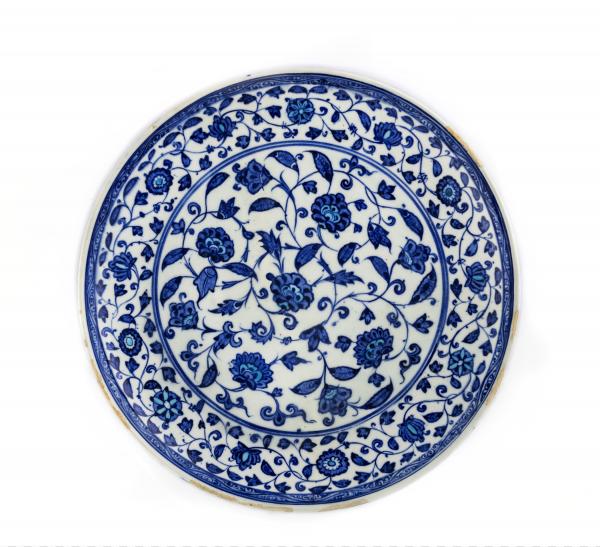Ceramics made in Iznik, in western Turkey, are one of the most renowned and influential arts of the Ottoman period. In the late 15th century, in emulation of the imported Chinese blue-and-white porcelain, which, along with gold and silver plate, served as the tableware of the Ottoman Sultan, Iznik potters began producing blue-and-white wares of a quality unequaled in Islamic ceramics. These potters created a compact, dense amalgam of clay, silica, and frit, which they covered with a white slip to replicate the hard white body of the Chinese porcelains. Onto this brilliant white surface, they painted floral motifs, arabesques, and other designs of Chinese and Islamic origin, in a deep cobalt blue, which they covered with a shiny colorless glaze. The palette of Iznik pottery changed over time, and toward the mid-16th century it expanded to include a grass green, and an intense red applied so thickly that it appears in relief, representing the classic phase of Iznik so widely admired in the West. Like the imported Chinese porcelains, of which over 10,000 examples are preserved at the Topkapi Palace, Iznik wares were similarly intended as tableware. However, Iznik pottery was made primarily for affluent urban consumers for everyday dining, demonstrating the high aesthetic standards of the day.
This superb dish belongs to an early phase in the development of Iznik ceramics in the first decades of the 16th century, by which time potters had begun to use two or more values of blue on a white ground. The dish employs turquoise blue accents, along with a deep cobalt blue and a lighter shade of blue, for its dynamic floral decoration drawn from Chinese designs but organized in the symmetrical manner that suited Ottoman taste. The rimless form found here is referred to as a sahn in Ottoman archival documents to designate something topped with a metal cover, which would keep the food warm on the often long trek from kitchen to dining room. Elite dining was communal, the food prepared in such a way that it could be eaten with the hand—with three fingers—or with a piece of bread. Dishes were served from such covered vessels in relatively rapid succession so that diners ended up with smaller portions but greater variety. A spectacular vessel such as this would once have been one of many even at a single meal. Today, it represents a rare survival and a beautiful example of cross-cultural influence and interchange.
During our 38th annual Collectors Committee Weekend (April 27–28, 2024), members of LACMA's Collectors Committee generously helped the museum acquire 10 works of art spanning a breadth of eras and cultures. Read more about all the acquisitions.



